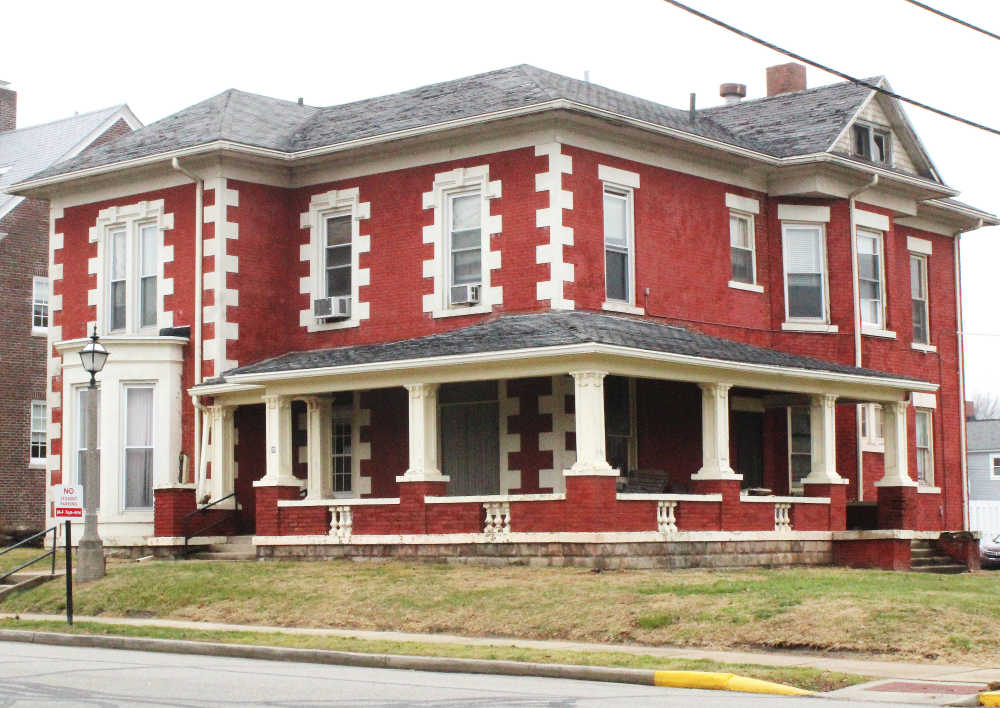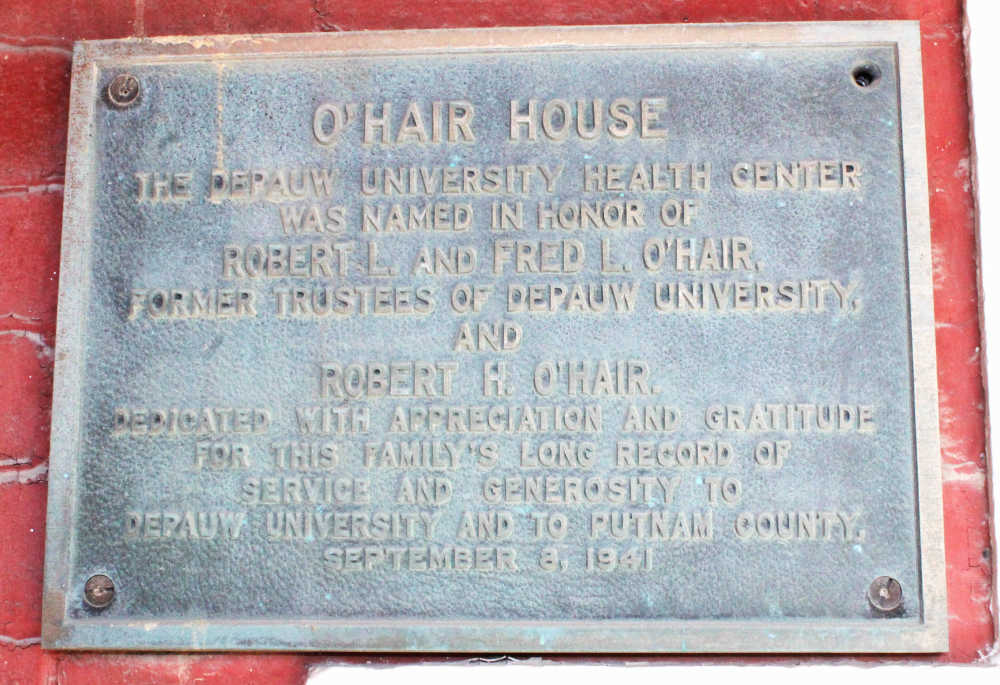Grant for assessment looms as boost for O’Hair House future

An Indiana Landmarks grant to conduct an assessment of the historic O’Hair House has been put to good use, a Heritage Preservation Society of Putnam County official said.
Indiana Landmarks recently announced that it had distributed $176,250 to nonprofit organizations in fiscal year 2019 to help preserve meaningful places across the state. Drawing from a variety of funds, the grants support projects ranging from structural analysis for endangered places to a documentary about the West Baden Colored Church and an effort to place a rural farmhouse on the National Register of Historic Places.
Among those was a $2,500 Efroymson Family Endangered Places grant to the Heritage Preservation Society for a rehabilitation assessment for O’Hair House owned by DePauw University.

The circa 1885 O’Hair House at Seminary and Spring streets in Greencastle has had a multitude of uses at DePauw, including being the site of the campus health clinic and faculty offices. A Sept. 8, 1941 plaque on the front of the building notes the naming of the DePauw Health Center in honor of Robert L. and Fred L. O’Hair, former trustees of DePauw, and Robert H. O’Hair, for the family’s “long record of service to DePauw and to Putnam County.”
Assessment of the building has already occurred, Preservation Society spokesman Phil Gick told the Banner Graphic, noting that the process has been ongoing for 18 months.
Gick offered props to DePauw for “not going in and bulldozing it down, and giving us a chance to do something about it.”
However, the building has had a lot of damage, Gick said, noting that it has suffered from “benign neglect” as well as a series of changes to the interior “that have not been kind” to the building.
“Almost everything that should have been done (to the building) wasn’t and everything that shouldn’t have been was,” Gick commented.
Indiana Landmarks has been engaged in the process, while an engineer from Bloomington has done the assessment on the property.
“We don’t have a solution yet,” Gick said, “but we’re working on it.”
Preservationists are trying to find someone willing to take on the project without ownership of the structure but with a long-term lease.
“DePauw has no interest in selling the property,” Gick advised. “They don’t want to lose the land.”
That’s understandable since O’Hair House sits in the middle of the north end of campus, and is adjacent to the new Robert G. Bottoms Alumni Center, which occupies the northeast corner of Seminary Street and College Avenue.
Gick foresees the building as more likely residential than commercial. Turning it into four one-bedroom units or two three-bedroom units might be attractive to DePauw alumni, he said, the way several buildings downtown have been.
“We’re trying to find somebody or a collection of individuals who would see a way of getting some benefit out of it,” Gick suggested.
“Beauty is in the eye of the beholder,” he added, agreeing that as a residential entity, the building would guarantee its owners space on campus for major university events that traditionally sell out area hotels.
It could essentially function as a time-share if more than one investor bought in.
“Exactly,” Gick said. “To somebody somewhere who likes the convenience of being right on campus and near the alumni center, it would be perfect.”
In a related matter, Gick said the O’Hair House that caught fire last summer on U.S. 231 near Brick Chapel is actually in better shape structurally than the O’Hair House on campus.
“It suffered from a massive fire but it’s more structurally sound,” Gick assessed, adding that the house north of Greencastle has been donated to Indiana Landmarks.
A temporary roof has been put on the two-story house to prevent further damage with more work coming this spring before it is marketed to someone to finish the restoration.
“Landmarks is dong the lion’s share of the collaborating,” Gick said, “with the insurance company paying some.”
Of the Efroymson Family Endangered Places Grants, the only other area recipient has been First Presbyterian Church, Brazil, which received $2,500 for a rehabilitation study for the 1924 church.
“Not only do these grants help with material costs associated with saving places important to communities, but they also often spark community action and inspire other giving,” said Marsh Davis, president of Indiana Landmarks, the country’s largest statewide nonprofit preservation organization. “In that way, they deliver a return that reaches well beyond a specific project and well beyond a dollar amount.”
Efroymson Family Endangered Places grants can be used for architectural and structural assessments, rehab cost analysis, and reuse studies.
Other grant recipients were:
-- The Cornerstone Society, Madison, $3,500 for a structural analysis of a fire-damaged 1844 house on West Street.
-- Develop New Albany, $2,000 to hire a consultant to recommend revitalization strategies along the city’s historic Vincennes Street corridor.
-- Fairfield Friends Meeting, Camby, $2,500 for reuse study of an 1892 meeting house and an 1871 school nearby.
-- Glenn H. Leopold Fund for Hazelden, Brook, $2,500 for rehabilitation plan for Hazelden, the 1902 estate built for playwright George Ade.
-- Masonic Temple Corporation, Connersville, $3,500 for a reuse study of the 1831 Elmhurst Mansion.
-- Main Street Greensburg, $3,500 for a reuse study of the 1885 St. Mary’s Catholic Church and 1917 school.
-- Montgomery Township, Jennings County, $2,000 for a reuse study of the 1953 Paris Crossing Gym.
-- Miller Historical Society, Gary, $2,500 for a rehabilitation plan for the 1911 Miller Town Hall.
-- Next Step Foundation, Terre Haute, $2,500 for a rehabilitation study for the 1894 Washington Avenue Presbyterian Church.
-- Osborn Prairie Christian Church, Veedersburg, $2,400 for a structural assessment for the 1892 church.
-- Promoting Wildcat Valley, Carroll County, $1,600 for a rehabilitation plan for the 1848 American House Hotel in Burlington.
-- Town of Lewisville, $2,500 for rehabilitation plan of the circa 1835 Houston Block on the Historic National Road.
-- Veedersburg Revitalization Association, $2,500 for a rehabilitation plan for adaptive reuse of the 1903 Cloverleaf Depot.
-- Wabash Valley Trust, West Lafayette, $3,500 for assessments of the 1896 library and administration building at the Indiana Veterans’ Home.
-- Whitley County Economic Development, Columbia City, $2,500 for rehabilitation plan of a circa 1900 commercial building in downtown Columbia City.
